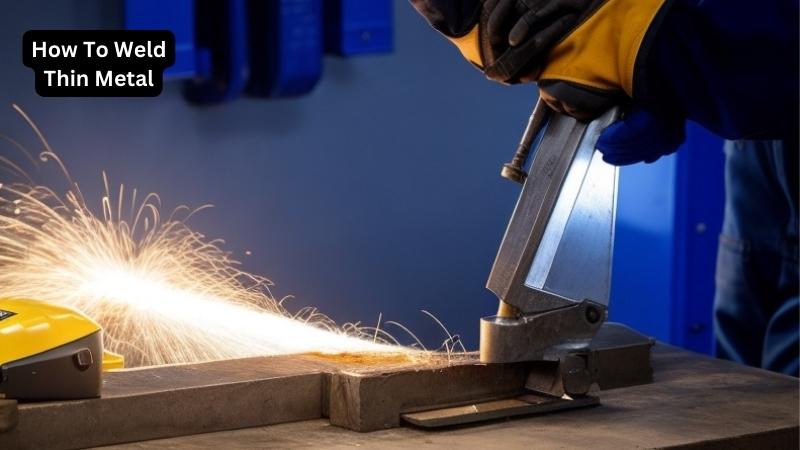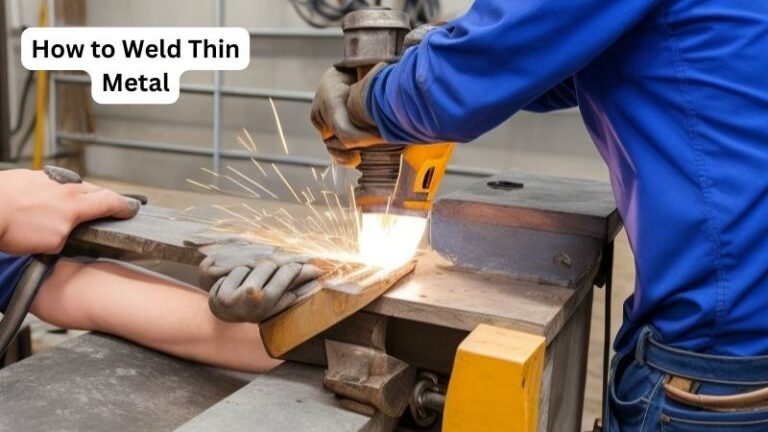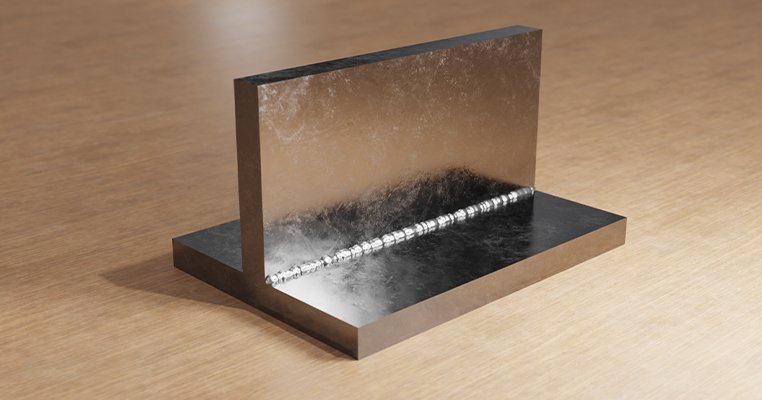How To Weld Thin Metal
Welcome to the world of welding! In this article, we’ll be talking about How To Weld Thin Metal. If you’re a budding welder or just curious about the process, you’re in the right place.
Have you ever wondered how those sleek and sturdy metal structures are created? Well, welding is the magic that brings metal pieces together, creating a bond that lasts. But when it comes to welding thin metal, there are a few things you need to know to achieve a clean and strong weld.
So, whether you’re planning to embark on a DIY project or looking to expand your skills, we’ve got you covered. Get ready to dive into the fascinating world of welding thin metal and learn the tips and tricks for successful and professional-looking welds. Let’s get started!
Welding Thin Metal: A Step-by-Step Guide
- Gather the necessary equipment: welding machine, safety gear, and thin metal sheets.
- Prepare the work area and ensure adequate ventilation.
- Clean the metal surface to remove any dirt or contaminants.
- Set up the welding machine according to the manufacturer’s instructions.
- Practice proper welding techniques, starting with small weld beads and gradually increasing the length.
- Allow the weld to cool and inspect for any defects.
- Repeat the process as needed, making adjustments as necessary. Happy welding!
How to Weld Thin Metal: A Comprehensive Guide
Welding is a crucial skill in various industries, and mastering the technique of welding thin metal can be particularly valuable. Whether you’re working on automotive repairs, DIY projects, or even art installations, being able to effectively weld thin metal can open up a world of possibilities. In this guide, we will delve into the techniques, equipment, and tips you need to know to weld thin metal with precision and confidence.
Understanding Thin Metal Welding:
Welding thin metal requires a different approach compared to thicker materials. Thin metal tends to heat up faster and is more susceptible to warping and distortion during the welding process. It’s crucial to understand the characteristics of thin metal and the appropriate techniques to ensure clean and strong welds.
One of the key considerations when welding thin metal is controlling the heat input. Excessive heat can cause the metal to become too hot, leading to distortion and even burn-through. Therefore, it’s important to use lower heat settings on your welding machine and proper technique to distribute the heat evenly.
In addition, choosing the right filler material is essential when welding thin metal. Thinner filler wires or electrodes are recommended to minimize heat input and prevent excessive buildup. Utilizing a technique such as TIG welding (Tungsten Inert Gas) can provide better control and precision when welding thin metal.
Equipment and Safety Precautions:
Before diving into the welding process, it’s essential to have the right equipment and safety measures in place. Here are some key elements to consider:
- Welding Machine: Invest in a welding machine that allows for precise control of heat settings. TIG and MIG welding machines are commonly used for welding thin metal.
- Protective Gear: Wear appropriate safety gear, including welding helmets, gloves, and flame-resistant clothing, to protect yourself from sparks, fumes, and UV radiation.
- Work Area: Ensure you have a well-ventilated work area and that there are no flammable materials nearby. It’s also important to have a fire extinguisher within reach.
By equipping yourself with the necessary tools and taking adequate safety precautions, you can weld thin metal safely and effectively.

Preparing the Metal Surface:
Properly preparing the metal surface is crucial for achieving high-quality welds on thin metal. Before welding, make sure to clean the surface from dirt, grease, rust, or any other contaminants. Solvents, wire brushes, or sandpaper can be used to remove these impurities.
In addition to cleaning, it’s also important to properly fit and align the pieces you are welding. Proper alignment ensures that the weld will have full penetration and strength. If necessary, use clamps or jigs to hold the metal pieces in place during the welding process.
Lastly, it is recommended to bevel the edges of the metal if you are welding thicker pieces together. Beveling creates a V-shaped groove that provides better penetration and stronger welds. However, for thin metal, beveling may not be necessary, as it can weaken the material. Consult welding guidelines or experts to determine the appropriate preparation steps for the specific type and thickness of metal you are working with.
Techniques for Welding Thin Metal:
When it comes to welding thin metal, there are several techniques that can provide clean and secure welds.
Tack Welding
Tack welding involves creating small, intermittent welds along the joint to hold the metal pieces together temporarily. Tack welds provide stability and prevent the metal from shifting during the welding process. Additionally, they allow for easier adjustments if needed before committing to a full weld. Tack welds should be evenly spaced and placed strategically to ensure proper alignment.
Stitch Welding
Stitch welding is a technique that involves creating a sequence of short welds along the joint, rather than one continuous weld. This technique helps to control heat input and reduces the risk of warping or distorting thin metal. Stitch welding allows for cooling breaks between welds, preventing excessive heat buildup.
Pulsed TIG Welding
Pulsed TIG welding is a technique commonly used for welding thin metal. It involves using a TIG welding machine with a pulsing feature, which alternates between high and low currents rapidly. This technique allows for better control of heat input and reduces the risk of burn-through and distortion. Pulsed TIG welding produces clean, precise welds on thin metal.
Troubleshooting and Tips
Welding thin metal can present some challenges, but with the right techniques and troubleshooting, you can overcome them. Here are a few common issues you may encounter and tips for addressing them:
Burn-Through
If you are experiencing burn-through when welding thin metal, try reducing the heat input by lowering the voltage or using a smaller electrode or filler wire. Additionally, using a pulsing technique or stitch welding can help control the heat and prevent burn-through.
Distortion or Warping
To minimize distortion or warping, ensure that you are using proper clamping techniques or fixtures to hold the metal in place during welding. Distributing heat evenly and avoiding excessive heat input can also help prevent distortion. Additionally, using a technique such as tack welding or stitch welding can provide better stability and reduce the chance of distortion.
Porosity
Porosity, or the presence of small holes or voids in the weld, can be minimized by ensuring a clean and properly prepared surface. Avoid welding in humid or contaminated environments and use the appropriate shielding gas and filler material for your welding process.
Remember, practice makes perfect when it comes to welding thin metal. Take the time to experiment with different techniques and settings to find what works best for your specific project. With patience and perseverance, you can achieve strong, clean welds on even the thinnest metal.
Choosing the Right Welding Method:
When it comes to welding thin metal, various methods can be employed depending on the specific requirements of your project. Here are three popular welding methods and their suitability for welding thin metal.
TIG Welding (Tungsten Inert Gas)
TIG welding is a highly precise and versatile method that is commonly used for welding thin metal. By using a non-consumable tungsten electrode and a shielding gas, TIG welding allows for controlled heat input and excellent weld quality. The ability to adjust heat settings and use a foot pedal for precise control makes TIG welding ideal for thin metal applications.
One of the main advantages of TIG welding for thin metal is its ability to provide clean and aesthetically pleasing welds. The process allows for greater control over heat input, resulting in minimal distortion and a smaller heat-affected zone. TIG welding is often used in industries such as aerospace, automotive, and art, where a high level of precision is required.
MIG Welding (Metal Inert Gas)
MIG welding is another popular method for welding thin metal. It utilizes a consumable wire that is fed through a welding gun, along with a shielding gas, to create the weld. MIG welding is known for its speed and efficiency, making it a preferred method for industrial applications.
When it comes to welding thin metal, MIG welding can be effective if the appropriate settings and techniques are used. It is crucial to adjust the heat and wire speed to prevent excessive heat input that can cause burn-through or distortion. Using the proper filler wire and shielding gas is also essential for high-quality welds on thin metal.
Stick Welding (Shielded Metal Arc Welding)
Stick welding, also known as Shielded Metal Arc Welding (SMAW), is a versatile welding method that can be used for a wide range of materials and thicknesses. While SMAW is not commonly used for thin metal due to its higher heat input and potential for distortion, it can still be an option for certain applications.
When stick welding thin metal, it’s essential to use the appropriate electrode and adjust the heat settings to minimize heat input. A lower amperage and a shorter arc length can help prevent distortion and burn-through.
However, it’s important to note that stick welding may not provide the same level of precision and clean welds as TIG or MIG welding in thin metal applications.
Best Practices and Tips for Welding Thin Metal:
1. Seek Proper Training and Practice
Before attempting to weld thin metal, it’s crucial to receive proper training and practice the techniques. Taking classes or seeking guidance from experienced welders can provide valuable insights and help you gain confidence in your welding abilities.
2. Start with a Clean and Well-Prepared Surface
Ensure that the metal surface is clean, free from contaminants, and properly prepared. Clean the surface using solvents, wire brushes, or sandpaper, as required. Additionally, make sure the metal pieces are properly aligned and fitted before starting the welding process.
3. Use the Appropriate Welding Method and Settings
Choose the welding method that best suits your project and adjust the settings accordingly. Lower heat settings, slower wire speed, and smaller electrodes/filler wires are generally recommended for welding thin metal. Seek advice from experts or refer to welding guidelines for specific recommendations.
4. Employ Tack Welding or Stitch Welding Techniques
Using tack welds or stitch welds can provide better control and stability when welding thin metal. These techniques help to distribute heat, prevent distortion, and allow for adjustments before committing to a full weld.
5. Monitor Heat Input and Welding Speed
Keep a close eye on the heat input and ensure that it remains within the appropriate range for thin metal. Avoid excessive heat that can cause burn-through or distortion. Similarly, consider your welding speed to maintain control and accuracy during the process.
6. Practice Patience and Take Breaks
Welding thin metal requires precision and attention to detail. Take breaks between welds to allow the metal to cool and release any built-up heat. Patience and a methodical approach can result in cleaner and stronger welds.
7. Consider Back Purging for Critical Welds
If you are working on critical welds that require exceptional quality and strength, consider back purging. Back purging involves introducing an inert gas on the backside of the weld to create a shielded environment, reducing the risk of oxidation and improving the quality of the weld.
8. Practice Welding Techniques on Scrap Metal
Before tackling your project, practice the welding techniques on scrap pieces of the same material and thickness. This allows you to fine-tune your skills, test different settings, and gain confidence before working on your desired project.
9. Post-Welding Processes
After completing the welds, remove any slag or splatter and clean the area surrounding the weld. Inspect the weld for any defects and perform necessary post-welding processes such as grinding or polishing to achieve the desired finish.
With these best practices and tips in mind, you can weld thin metal successfully and create high-quality, secure welds. Remember, practice is key to mastering the art of welding thin metal, so don’t be afraid to experiment and learn from each welding experience.
Common Challenges and Solutions in Welding Thin Metal:
1. Heat Control
One of the main challenges in welding thin metal is maintaining control over the heat. Thin metal tends to heat up quickly, increasing the risk of burn-through and distortion. To overcome this challenge, reduce the heat input by using lower amperage, adjusting the voltage or wire speed, and employing pulsing or stitch welding techniques.
2. Distortion and Warping
Due to the sensitivity of thin metal to heat, distortion and warping are common challenges when welding. To minimize these issues, use proper clamping techniques or fixtures to hold the metal in place during welding. Distribute the heat evenly by moving the heat source in a controlled manner and consider using tack welds or stitch welding to reduce the heat input in localized areas.
3. Burn-Through
Burn-through, which occurs when the heat input is excessive, can weaken and deform thin metal. To avoid burn-through, reduce the heat input by adjusting the amperage, voltage, or wire speed. Utilizing a smaller electrode or filler wire can also help to control the heat in thin metal welding.
4. Controlling Warpage in Sheet Metal
Sheet metal, being extremely thin, is particularly prone to warping during welding. To control warpage, take extra precautions such as clamping the sheet metal tightly, tack welding at regular intervals, and using a back purging technique. Implementing these measures will help maintain the flatness and shape of the sheet metal during the welding process.
5. Proper Joint Fit-Up
Obtaining a proper joint fit-up is crucial when welding thin metal. Ensure that the pieces to be welded are properly aligned and adequately prepared. Proper joint fit-up reduces the risk of weak welds or insufficient fusion and enhances the overall strength and integrity of the weld joint.
6. Porosity
Porosity, the presence of gas pockets or voids within the weld, can compromise the strength and quality of the weld. To mitigate porosity when welding thin metal, ensure a clean working environment, remove any moisture or contaminants from the metal surface, and use the appropriate shielding gas or flux for your welding process.
7. Preheating
Preheating is occasionally used in thin metal welding to reduce the risk of cracking and improve the weld penetration. However, preheating should be approached with caution, as excessive heat can lead to increased distortion and warping. Follow welding guidelines or seek professional advice to determine if preheating is necessary for your specific thin metal welding project.
By being aware of these common challenges and employing the appropriate solutions, you can overcome the difficulties associated with welding thin metal and achieve high-quality, durable welds.
The Advantages of Welding Thin Metal:
Welding thin metal brings various advantages and opportunities, making it a valuable skill to acquire. Here are some benefits of welding thin metal:
Versatility
Thin metal offers versatility in terms of applications and possibilities. Whether you’re working on automotive repairs, creating intricate artwork, or constructing lightweight structures, welding thin metal allows you to work with materials that require precision and fine detail.
Lightweight Structures
Thin metal is often used in the construction of lightweight structures where strength and durability are still essential. By mastering the art of welding thin metal, you can contribute to the creation of strong and lightweight frameworks, such as those found in aircraft, bicycles, or shelving units.
Artistic Applications
Welding thin metal opens up a world of artistic possibilities. From sculptures to jewelry, thin metal can be transformed into unique and visually appealing creations. Being able to skillfully weld thin metal enables you to explore your creativity and bring your artistic vision to life.
Increased Efficiency
Welding thin metal often requires less material, resulting in cost savings and improved efficiency. Additionally, thin metal can be easier to manipulate and work with compared to thicker materials, allowing you to complete projects more quickly and efficiently.
Integration with Technology
Thin metal is commonly used in electronic components and technology-related applications. By mastering the techniques of welding thin metal, you can contribute to the manufacturing and assembly of various electronic devices, providing opportunities in industries such as consumer electronics or renewable energy.
Overall, the ability to weld thin metal opens up a diverse range of opportunities across multiple industries. By honing your skills and understanding the nuances of welding thin metal, you can embark on a rewarding journey filled with creativity, precision, and innovation.
Key Takeaways – How To Weld Thin Metal
- Start with a clean and properly prepared surface.
- Choose the right welding method for thin metal, such as MIG welding.
- Use the correct size of welding wire for thin metal.
- Control your heat and speed to prevent warping or burning through the metal.
- Practice and gain experience to improve your welding skills on thin metal.
Faqs for How To Weld Thin Metal:
Before starting, make sure the surface is clean and free from rust, paint, or any contaminants. Next, secure the thin metal to a sturdy surface or use clamps to hold it in place.
It’s crucial to wear protective gear such as welding gloves, a welding helmet, and flame-resistant clothing. Lastly, ensure you are working in a well-ventilated area or use an exhaust fan to remove fumes.
By taking these precautions, you’ll create a safer working environment and achieve better welding results with thin metal.
TIG (Tungsten Inert Gas) welding is generally considered the best process for welding thin metal. TIG welding allows for precise control of the heat input, reducing the risk of distortion, warping, or burn-through on thin materials.
The TIG welding process involves using a tungsten electrode to create an arc that melts the metal. A filler metal may also be added to create a strong bond. With its low heat input and precise control, TIG welding is ideal for welding thin metal, providing clean, high-quality welds.
One of the challenges when welding thin metal is the increased risk of overheating. With thin materials, it’s important to control the heat and avoid applying excessive heat, as it can lead to distortion or even burn-through. Maintaining a steady hand and using appropriate welding techniques can help overcome this challenge.
Another common challenge is maintaining proper penetration. Thinner metal requires a lower amperage setting to prevent excessive penetration. It’s important to practice and adjust the settings accordingly to achieve the desired weld strength without compromising the integrity of the thin metal.
When welding thin metal, it’s recommended to use techniques such as tack welding or stitch welding. Tack welding involves temporarily welding small points to hold the metal pieces together, providing stability before making the final weld.
Stitch welding involves making short welds along the joint to distribute heat evenly and prevent distortion.
Using these techniques, along with proper control of the heat input and weld speed, will help you achieve strong and reliable welds on thin metal.
Yes, when welding thin metal, it’s important to fine-tune your welding machine settings. Reduce the amperage to a lower setting to prevent excess heat and minimize the risk of burn-through. Adjust the welding speed accordingly to maintain proper control and penetration.
How To Mig Weld SUPER Thin Metal with (NO WARPING)
Summary:
If you want to weld thin metal, there are a few important things to remember. First, use a small welding machine with low heat settings. Second, clean the metal surface thoroughly before starting. Third, practice your welding technique on scrap metal first. And finally, take your time and go slow to avoid overheating the metal.
In addition, remember to use welding techniques like tack welding and backstepping to minimize warping. It’s also important to wear protective gear like gloves, goggles, and a welding helmet to stay safe. By following these guidelines, you can successfully weld thin metal and create strong and reliable joints.


